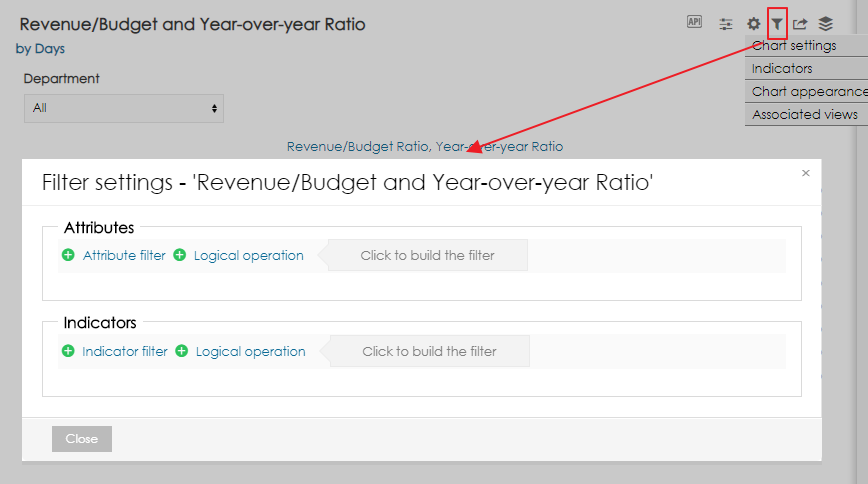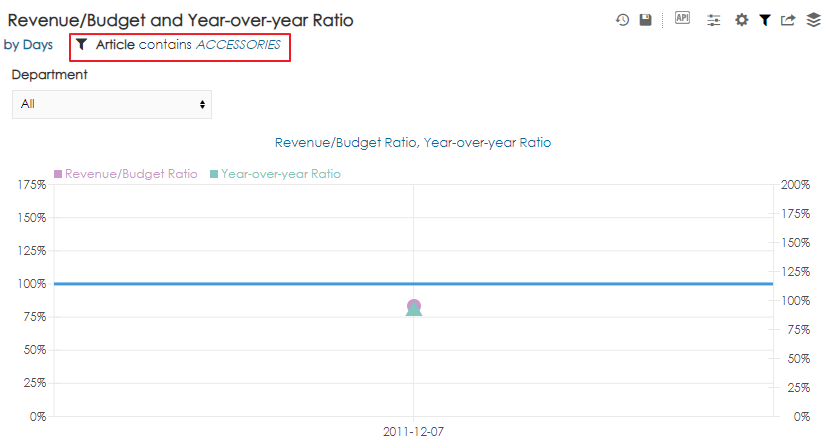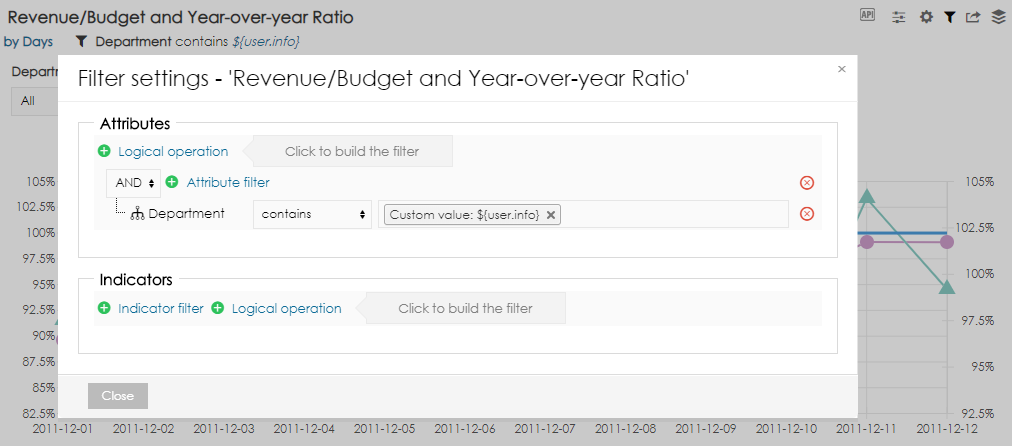Filter option is available for Chart, Table, Geo map and KPI label view.
Static filters are used to display only a subset of the data in the view. Users can modify these filters, but they are generally used as static filters which are configured during the setup of the report.
You can access Filter option from toolbox in the upper right corner of the view.
Filter dialog includes list of attributes and indicators used in the view. You can filter either by:
- Attribute members
- Indicator values
To apply a filter, you have to:
- Select Attribute or Indicator for filtering.
- Select Condition.
- Provide Values for the condition.
FILTERING BY ATTRIBUTE MEMBERS
There are four conditions available:
- contains: Allows to select single or more members, which will be displayed within the attribute.
- doesn't contain: Allows to select single or more members, which will not be displayed within the attribute.
- count: Allows filtering members by their count.
- not empty: Hides members with empty (blank) values.
- empty: Displays members with empty (blank) values.
Filtering by date and datetime variables
For date and datetime attributes, it is also possible to use relative variables, such as:
| Relative date | Actual value |
|---|---|
| now | Current day |
| actualDay | Current day |
actualWeek | Current week (first day of week) For example, actualWeek selected on 21.9.2010 represents date 20.9.2010 (Monday of this week in calendar) |
| actualMonth | Current month (first day of month) For example, actualMonth selected in 21.9.2010 represents date 1.9.2010 |
| actualQuarter | Current quarter (first day of quarter) For example, actualQuarter selected on 21.9.2010 represents date 1.7.2010 |
| actualYear | Current year (1st January of current year) For example, actualYear selected on 21.9.2010 represents date 1.1.2010 |
| availableFrom, availableTo | Represents the first and last available date entry |
Relative and absolute date can be adjusted by operators using this syntax: date +|- n[d|w|m|q|y], where n is integer, d represents day, w represents week, m represents month q represents quarter and y represents year. We can for example define time in this way: actualyear + 2m -4d. Today is 21.9.2010, so this value represents 1.1.2010 + 2 months - 4 days, which means date 25.2.2010.
| Modifier | Value |
|---|---|
| d | days |
| w | week |
| m | month |
| q | quarter |
| y | year |
| H | hour |
| M | minute |
| s | second |
Examples for datetime:
- now-1mTnow-1M
- now-2dTnow-5H-30M-30s
Examples for date:
- now-5d
- actualMonth-1m
FILTERING BY INDICATOR VALUES
Following conditions are available:
- equals the value specified
- not equal to value specified
- lower than value specified
- lower than or equal to value specified
- greater than value specified
- greater than or equal to value specified
- not empty
- empty
Filtering by indicator values is defined only for basic cases. It can produce unpredictable result if you use complex drill-down paths or date/time dimension.
MULTIPLE FILTERS
You can combine different attributes/indicators or even apply more conditions for one attribute/indicator. Multiple filters can be merged with AND or OR condition.
MODIFYING FILTER
Applied filters are listed under the view title and labeled with Filter tag. In case of attribute filter, you can click on the condition to modify values.
COPYING EXISTING FILTER
Since BellaDati 2.9.9, it is possible to copy the whole filter configuration from one view to another. The views have to be in the same report.
- Open filter settings of a view which does not have any filters.
- In the box Copy existing filter and select a view. The filters from the selected view will be copied.
REFERENCING CURRENT USER ATTRIBUTES IN FILTER
You can access the current signed user attributes to build the filter. In order to do this, add a custom expression as a filter value:
| Name | Description |
|---|---|
| ${user}, ${user.username} | Returns the username of currently signed user |
| ${user.email} | Returns the email of currently signed user |
| ${user.name} | Returns the first name of currently signed user |
| ${user.surname} | Returns the last name of currently signed user |
| ${user.locale} | Returns the user's locale of currently signed user |
| ${user.info} | Returns value from user field additional info. |
| ${domain}, ${domain.name} | Returns the name of currently signed user's domain |
| ${domain.locale} | Returns the locale of currently signed user's domain |
| ${domain.timezone} | Returns the timezone of currently signed user's domain |
See example here:
USING WILDCARDS IN FILTERS
You can use wildcards in BellaDati which allow you to substitute any number of characters in the custom value.
| Name | Description |
|---|---|
| % | Replace zero or any number of characters. |
| _ | Replace one single character |




